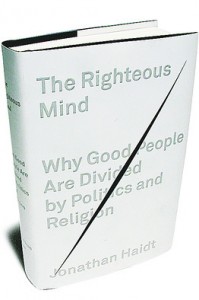I recently finished reading Professor Jonathan Haidt’s new book The Righteous Mind and found it to be utterly fascinating. The objective of the book is to present readers with a nuanced psychologically based reason for why people  of good will and character differ so sharply and so strongly on critical issues. He specifically draws our attention to the subjects of religion and politics but his theory could be applied to any subject on which people passionately and vigorously disagree.
of good will and character differ so sharply and so strongly on critical issues. He specifically draws our attention to the subjects of religion and politics but his theory could be applied to any subject on which people passionately and vigorously disagree.
This is one book that I think people should take the time to read and seriously consider. He presents his findings in a compelling and easy to understand format, employing metaphor and narrative to make his research accessible to even those who do not possess any background in moral reasoning or psychology. I will just take one idea from his book, which is an idea he has written about in his other works, and connect it to the most basic component of Jewish thought. He writes:
“… I called these two kinds of cognition [intuition and reasoning] the rider (controlled processes, including “reasoning-why”) and the elephant (automatic processes, including emotion, intuition, and all forms of “seeing-that”). I chose an elephant because rather than a horse because elephants are so much bigger — and smarter — than horses. Automatic processes run the human mind, just as they have been running animal minds for 500 million years, so they’re very good at what they do, like software that has been improved through thousands of product cycles. When human beings evolved the capacity for language and reasoning at some point in the last million years, the brain did not rewire itself to hand over the reins to a new and inexperienced charioteer. Rather the rider (language-based reasoning) evolved because it did something useful for the elephant… We make our first judgments rapidly, and we are dreadful at seeking out evidence that might disconfirm those initial judgments. Yet friends can do for us what we cannot do for ourselves: they can challenge us, giving us reasons and arguments that sometimes trigger new intuitions, there making it possible for us to change our minds. We occasionally do this when mulling a problem by ourselves, suddenly seeing things in a new light or from a new perspective… this process doesn’t seen to happen very often.” – The Righteous Mind, pgs. 44-47
Haidt articulates a two-fold approach to how we encounter the world. Firstly we have “the elephant,” which is the automatic reactions such as emotions. Secondly we have “the rider,” which is the thought out, directed reactions that come from reasoning and thinking. The former has developed since the dawn of humanity whereas the latter only came into being once we developed the capacity for reasoning and language. The former is very hard to change, mainly because the auto-pilot is done so well that we barely ever realize it is being employed. The latter is also hard to change but since it is more conscious, we are aware of when we are rationalizing or justifying and can change it. The latter also has the ability, over time, to change the course of the former, albeit with great work and effort. He mentions that the most common way we do change “the rider” and thereby lead the way for eventually changing “the elephant” is through our network and web of social interactions. Humans are inherently social and it is through the opinions and interactions with others that we can bring about change.
However, the second method, that of thinking long and hard about a problem by ourselves, of self-reflection and introspection is another method. It is one that Haidt does not see very likely and rarely utilized. This does conform very much to our current cultural climate. It is hard to find even a moment of quiet in one’s day to think. Moreover, the times we do have in between appointments or commuting to and from work are spent with our iPhone and iPad consuming media content, whether it be movies, television shows, MP3s or the latest edition of Angry Birds.
Judaism does offer a tool by which we can connect with our own internal process throughout the day. The mandated recitation of berachot, of blessings, prior and after performing many mundane daily actions, are ideally a moment afforded to the busy and distracted person to check in with “the rider” and to reassess our “reasoning-why.” Furthermore, the additional mandated three daily prayer services carves out in time for the overwhelmed individual moments that extend far beyond the recitation of a blessing before or after consuming food, to connect and reassess. The truth being that those moments of blessings and prayers are also relational, except that it is not in conversation with another person but in conversation with God (Talmud, Berachot 33a).
It is quite difficult to access these ritual opportunities fully and not fall back on rote recitation. Yet, it is also difficult in general to alter “the rider” and the course of “the elephant” but that does not mean that we should not attempt to do so for the better and good of ourselves. Even if we fail most of the time to use these ritual opportunities as times to reassess and reevaluate, striving to do so will lead us to check in at least some of the time, and that will be of tremendous benefit to us as individuals concerned with our growth and development.












